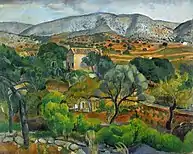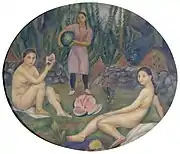Joaquim Sunyer
Joaquim Sunyer (Catalan pronunciation: [ʒuaˈkim suˈɲe]) (Sitges, 1874–1956) was a Catalan painter often linked to the Noucentisme movement.
He began his artistic education with his uncle, Joaquim Mir, later moving to Barcelona where his fellow students included Joaquín Torres García, Isidro Nonell,[1] and Joaquin Mir Trinxet. In 1896 he moved to Paris, where he became acquainted with the neo-impressionist movement and worked extensively in the style. His paintings of this period include street scenes of working-class life. He also produced graphic works influenced by Toulouse-Lautrec and Théophile Steinlen that emphasize urban night life and urban poverty.[1] He was friends with Picasso, and in the first years of the 20th century the two artists' work were similar in style and subject.[1]
In 1908, Sunyer turned away from Parisian subject matter in favor of the themes that would occupy him for the rest of his life, especially nudes in pastoral landscapes, family scenes, women, and children.[2] He returned to Spain in 1911, establishing himself in his hometown of Sitges. There he painted numerous landscape paintings in which he highlights his preoccupation with capturing the Mediterranean light through the use of very light colours marking a clear rupture with his darker paintings executed in Paris. His compositions are noted as an example of balance, though sacrificing technical perfection for the benefit of a more intense evocative power.
He was an important influence on younger Catalan artists such as Miro.[1]
Gallery
 Landscape by Sunyer, 1913
Landscape by Sunyer, 1913 La sandía (The Watermelon), 1920, oil on canvas, 59 x 71.5 cm, Museu Nacional d'Art de Catalunya, exhibited Exposició d'Art francès d'Avantguarda, Galeries Dalmau, Barcelona, 1920
La sandía (The Watermelon), 1920, oil on canvas, 59 x 71.5 cm, Museu Nacional d'Art de Catalunya, exhibited Exposició d'Art francès d'Avantguarda, Galeries Dalmau, Barcelona, 1920
Notes
- Cowling and Mundy, p. 251.
- Cowling and Mundy, p. 252.
